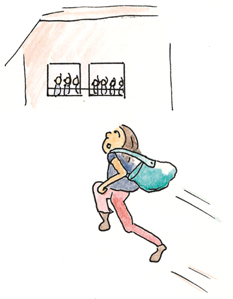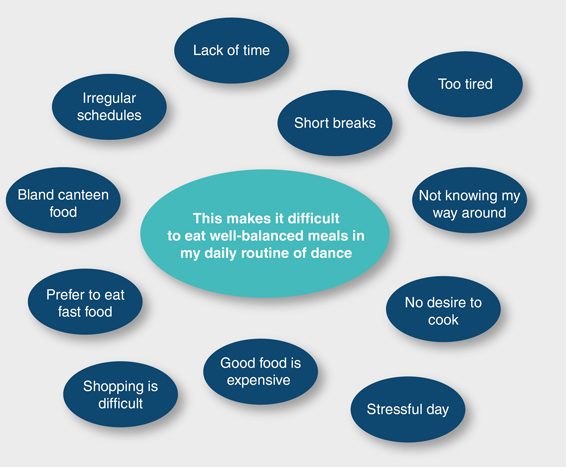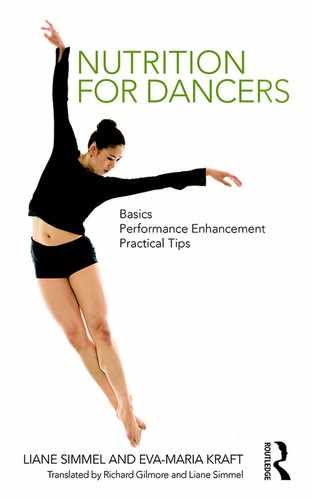It is not always easy to find the time to eat between dance classes, rehearsals, and performances, or to fit meals in between daily work routine or school schedule and dance classes. Often, one runs from one thing to the next and breaks are too short for a leisurely meal. Many dancers have almost no time to eat during the day, as dancing with a full stomach is not easy, and time to digest is rare. Habits that develop out of such a life style are often physically draining: we go through the whole day eating very little, and only later in the evening do we find the time to eat properly. After arriving home late, we are overcome with hunger and start eating the raw ingredients instead of preparing the meal. This is a sure sign that the last meal was too long ago. And, even if we do manage to wait for the meal to be cooked, hunger causes us to put more on the plate than we can possibly digest. Eating a large portion on an almost empty stomach can cause stomach pains or feelings of being stuffed. The implication is clear: if this scenario is all too familiar to you, then it is time to rethink the timing of your meals.
Some dancers believe that waiting for extended time periods between meals and snacks or waiting until hunger can’t be ignored leads to better weight management. But quite aside from the danger of overeating, which puts a strain on the stomach and digestion, this pattern of behaviour has another negative side: hunger causes us to subconsciously favour sweet and fatty foods. We choose apple pie instead of an apple as a snack. In the long run, this can result in weight gain.

Being tired throughout the day can have many causes but one of them could be an inadequate diet. Taking long breaks between meals causes the blood sugar to fall, reducing the supply of glucose to the brain and resulting in a lack of concentration and tiredness. If one always craves a nap or relaxation after a meal it can point to an imbalance in the composition of the meal or a problem with its portion size. When the body digests, blood is drawn to the digestive tract at the cost of the circulation to the brain. The larger the amount we eat, the more demands are placed on the digestive system. The redistribution of the blood to the intestines and away from the brain makes it hard to think, leads to tiredness, and increases the need for sleep. A possible answer to these problems lies in having smaller portions at more frequent intervals (see p. 91).
Tip 
Investigate your optimal meal and snack timing! Experiment to find out which foods work for you at different times of the day.
Just as there is no universal solution for everyone when considering what is best to eat, there is no generic plan for when to eat. Warm breakfast in the morning might provide one person with sufficient energy for the first part of the day, while someone else feels better with a little snack shortly before each rehearsal. Everyone has to find their own way to their optimal meal plan.
Eating Around a Dancer’s Schedule
As a general rule, remember that carbohydrates serve as a source of quick energy and proteins give the body its building blocks (see Chapter 1, p. 7). One should get enough carbohydrates before and during dancing, and make sure to give the body enough protein afterwards.
Before Dancing: Stock up on Energy
Energy is the alpha and omega in dance. Training on an empty stomach not only depletes your strength, it also puts you at risk of fatigue. This will negatively affect your dance technique and make it difficult to concentrate. Being hungry in training not only puts a strain on the body but it also can take away the joy in it, when energy is lacking. Especially in the morning, when training sessions begin early, getting out of bed can be hard, and the idea of snoozing away every last minute instead of having breakfast is tempting. Yet, after sleeping, the body lacks energy. The blood sugar level is low, glycogen stores are low, and the body is waiting for replenishment – these are far from ideal conditions for a productive class. Even when training in the afternoon, or in the evening, it is important to make sure the last meal was not too many hours ago. Otherwise, the blood sugar will be too low for the body to achieve its potential. Energy needs to be restocked, ideally by enjoying a meal high in carbohydrates.

Eating before dancing takes thoughtful consideration, as an overly full stomach can put pressure on the diaphragm (see Diagram 1.2, p. 9) resulting in stomach pain, breathing difficulties or stitches. The intensity of the training session should dictate when you eat and what you eat. When it is an easy training session, you can eat a light snack shortly before it begins. The more intensive the workout, the more time you should allow between eating and training. The timing also depends on how quickly the foods you choose will be digested and how long they remain in the stomach before being passed on to the intestines. The digestion time in the stomach depends on many factors, one of which is the composition of the food.

Diagram 4.1:Average length of time foods and drinks remain in the stomach
Modified from Hamm, 2009.
The food’s consistency also influences the time it remains in the stomach. Fluid and blended foods, such as drinks, soups, or yoghurts are transported more quickly than solid foods. One can aid digestion by chewing thoroughly. Warm foods are generally digested more rapidly than cold foods because the warmth stimulates the stomach’s fluids. The size of the portions also plays a role: big portions rich in calories will be digested more slowly than smaller meals with fewer calories.
The longer the food remains in the stomach, the more filling it is. Therefore, fats which take the longest to pass through the stomach are the most filling, followed by proteins. Carbohydrates pass through the stomach rather quickly; therefore, after a meal with a lot of carbohydrates you can soon be hungry again.
Table 4.1:Recommendations for eating before dancing
| 3–4 hours before |
| Main meals (full portion)
This is the best time for a warm meal, since there is still enough time for digestion before dancing |
| 1–2 hours before |
| Main meals (half portions)
Snack (mixture of several foods) |
| 1 hour or less before |
| Snack (one food)
Drinks rich in carbohydrates |
For detailed information about content and preparation of main meals and snacks, see Chapter 3, p. 61 and p. 64.
Nervousness can upset the stomach. This is true in all situations, not just when dancing. Before a performance or an exam, your stomach may be particularly sensitive. If you have a big event coming up, make sure there is more time between the last meal and the beginning of your dancing. For, if the stomach is already tingling from nervousness, the digestion is even more difficult. Sometimes, however, a little snack can help to calm the stomach. For some people, nervousness stimulates the production of the stomach’s digestive acids and leads to heartburn. The simple trick of eating a small snack can help alleviate this problem.
Tip 
The shorter the time before eating and dancing, the smaller and easier to digest the meal you pick should be. If you cannot tolerate anything solid before dancing, try something creamy or liquid, like yogurt, or watered-down smoothies.
While Dancing: Maintaining Your Energy
Carbohydrates and fluids are the keys to staying fit in training, rehearsals, and performances. Make sure to drink regularly to maintain your fluid balance. This is crucial to preserve your performance over longer periods of time. To eat during the workout is seldom necessary in dance. When trainings and rehearsals last up to 90 minutes, fluids and carbohydrates can be replaced with hypo- or isotonic drinks (see Chapter 2, p. 44), and replacement of carbohydrates in the form of solid foods is not necessary.
Physical exertion and high core temperatures suppress hunger. While dancing, therefore, the absent hunger sensation is an unreliable indicator of your body’s energy requirements.
If you have several training sessions back to back, it is a different story. If the day’s rehearsal plan is tightly scheduled, nutritional snacks are essential. They provide energy during the break, keep the blood sugar level steady, refill the glycogen stores, and provide important minerals. Choose a selection of handy transportable snacks with easily digestible nutrients for short breaks (see Chapter 3, p. 64).
After Dancing: Accelerate Regeneration
If you are not hungry after training, there is no need to force yourself to eat. Drinks are equally capable of restoring the lost nutrients. The two main nutritional recommendations are a quick replacement of minerals and a rapid refilling of the glycogen stores. Especially with the latter, time is of the essence: empty glycogen stores can be refilled most easily in the first 45 to 60 minutes after a workout, so make sure to use this window of opportunity. Doing so will support your muscles’ performance.
Replacing your protein is just as important, but you have more time post-exercise. Countless bodily structures, like cells and tissues, break down during dancing. There are microtears in the muscles, damage to the enzymes, and cell abrasions. To help your body replace the broken materials quickly, it is necessary to provide it with protein, which will rebuild and regenerate the bodily structures. Take advantage of the fact that after a workout, muscles rebuild especially quickly.
Table 4.2:Recommendations for eating after dancing
| Up to 1 hour after dancing |
| Carbohydrates
to refill the glycogen stores |
| Fluids
to replace the minerals lost through perspiration |
| 1–3 hours after dancing |
| Protein
to repair damaged bodily structures |
Strictly speaking, training only ends when the body has been replenished. Getting the regenerative processes started and the energy depots refilled after a training is just as important as consuming the necessary nutrition beforehand. As in a dancer’s life, ‘after dance’ is ‘before dance’.
It is not just the physical work but the post-exercise refuelling that increases the body’s endurance and ability to perform. This is why you should use all opportunities to support your body’s regeneration process after dancing. The right nutrition plays a major role in this.
Aside from recommendations about what components should go into your diet (see Chapter 3, p. 52), nutritional science also offers advice about how to plan the timing of meals. There are two main variations suggested. One recommends dividing the total amount of food into five meals: three main meals and two snacks (see Table 4.3). Alternatively, one can divide all main meals and snacks into smaller portions and eat regularly throughout the day. Experiment with both to find which eating style suits you and your schedule best. Some people prefer several smaller portions so as not to feel too full up; others never really feel satisfied if their stomach is not filled at least once a day.
Table 4.3:Example of a daily nutrition plan
This plan was made for a female dancer (55 kg, 167 cm), with a daily requirement of 2475 kcal during medium-intensity training (about 10 hrs/week) or 1925 calories for days without training (see Chapter 6, p. 117).
Tips 
✓Figure out your own pattern of meals and snacks.
✓Avoid a ‘crescendo’ portion size towards the end of the day.
✓The shorter the time between dancing and eating, the smaller and more easily digestible the meals should be.
✓Make it a habit to eat one warm meal every day. Warm foods settle the stomach, stimulate the digestive juices, accelerate the activity of enzymes, and improve the digestion.
✓Due to possible difficulties when sleeping on a full stomach, plan 2 to 3 hours between dinner and your bedtime.
Reality Can Be a Different Story
As a dancer, you know this situation: just grab a sandwich quickly, chew it two to three times, then run off to the next rehearsal. Putting good intentions into practice is hard, especially for dancers, whose daily routine makes it often difficult to balance eating and dancing. Dancers need flexibility and improvisation in both dancing and their dietary plans.

In many professional dance schools, there is little time between classes. Often, there is only a 5- or 10-minute break, during which one also needs to change into dry clothes and get to a different studio. This hardly leaves time for eating. A good preparation pays off. Having a nutritious snack on hand means you can at least take a quick bite in a short amount of time. Even the lunch breaks are often short, leaving almost no time for a healthy meal. Again, planning is crucial, and maybe the left-overs of your warm meal from the night before can help you out. The more stress you have and the more densely packed your day is, the more important it is to have breakfast. A good, well-thought-out breakfast can provide the necessary calories to get through to the next break without falling into a pit of exhaustion. Besides not having enough time, other factors are often far from ideal. One seldom finds necessary space to keep things cool or heat up a meal. This makes it even more difficult for dancers to eat well.

Diagram 4.2:Factors that make it difficult to eat healthy meals in the dancer’s daily routine (answers from dance students taking nutritional seminars).
For professional dancers, dance teachers and ambitious amateurs alike, dance often takes place in the evenings. Frequently, that means getting home in the middle of the night; tired, and exhausted, and with a growling stomach. What should you do? Start cooking now? Just have a cold sandwich? Go to bed hungry? If you have not had anything warm all day and tomorrow looks like being the same again, the answer is clear: make the effort and spend some time cooking, even at this late hour. Maybe there are some left-overs in the fridge or freezer? It’s always a good idea to cook more on weekends, or when there is more time, and freeze portions for situations like these.
And what about the recommendation of having smaller portions in the evening to prevent the stomach from having to work so hard on digesting the food all night? This rule is still valid, but if you have not had a chance to eat much during the day, you do need energy and nutrients. The supply of sufficient calories takes priority, otherwise you will not have enough strength and energy to dance the following day.
